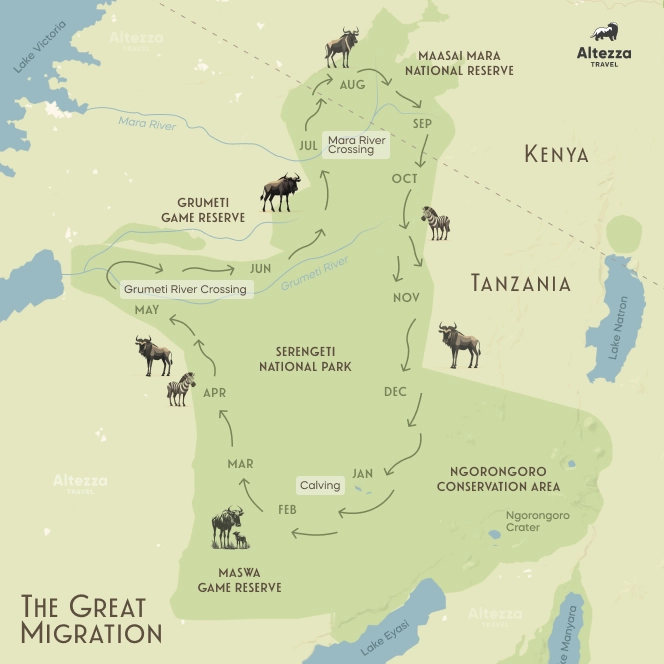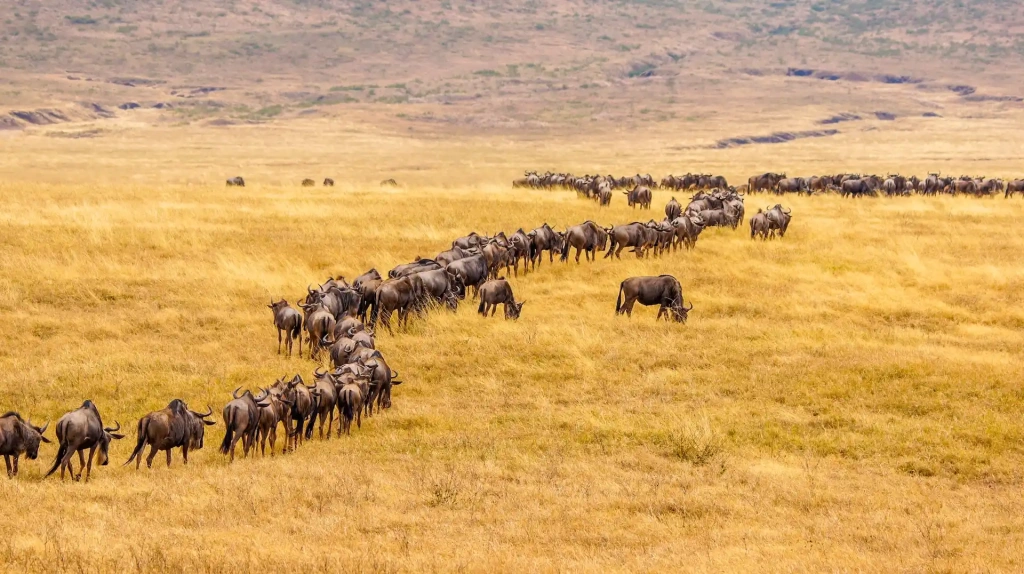Imagine witnessing millions of animals sweeping across the vast plains of East Africa — a breathtaking spectacle unlike any other on Earth. This is the Great Wildebeest Migration, the largest movement of land animals on the planet. Nearly 2 million wildebeest, zebras, and gazelles migrate across the Serengeti-Mara ecosystem in an endless cycle. Discover where and when to experience this awe-inspiring natural phenomenon in our detailed guide by Altezza Travel.
Where is the Great Wildebeest Migration?
The Great Wildebeest Migration takes place in East Africa, specifically in the Serengeti-Mara ecosystem — the oldest and last of its kind remaining on the planet. Stretching from northern Tanzania to southern Kenya, it encompasses indigenous reservations and protected wildlife zones like Serengeti National Park, the Ngorongoro Conservation Area, and, on the Kenyan side, the Maasai Mara Reserve. Most of the Great Wildebeest Migration occurs within Tanzania's Serengeti National Park.
This ecosystem covers about 40,000 square kilometers (approximately 15,500 square miles) and is home to several million animals, including wildebeest, Thomson's gazelles, zebras, buffalos, giraffes, elephants, hippos, lions, leopards, cheetahs, hyenas, and many others. This rich diversity is due to a variety of habitats, from lakes, rivers, and swamps to grasslands and forests.
The ecosystem is a living model of the complex interactions between wildlife and their environment, showcasing the life cycle in all its grandeur and harshness. Drought forces mammals to leave their habitats, storm fronts guide them toward fresh grass and water, and the lush plains provide ideal conditions for raising newborn calves. However, these vulnerable young also become prey for predators and scavengers.
What month is the Great Wildebeest Migration?
The Serengeti Wildebeest Migration is simultaneously a pursuit of life and a flight from death — a perpetual cycle in every sense. The wildebeest herds move clockwise along the borders of the Serengeti-Mara, journeying for 12 months each year.
The Great Migration month by month
UNESCO calls the Great Migration one of the "most impressive natural events" on the planet, visible even from space. The scale is awe-inspiring: about two million wildebeest and hundreds of thousands of gazelles and zebras gather into herds and traverse the African plains, covering a total distance of 800 to 1,000 kilometers (500 to 620 miles). This grand voyage has neither a beginning nor an end, only birth and death. Following this logic, we'll outline the migration route.
The Great Wildebeest Migration in January / February / March
At the beginning of the year, herds of ungulates arrive in the southern Serengeti plains along the eastern border of the national park, near Ngorongoro. By now, the rains have ended, and the plains are lush with fresh grass. The favorable weather creates ideal conditions for the calving season. Over two months, about 400,000 calves are born, becoming immediate targets for predators.
April / May
The wildebeest migrate northwest toward central Serengeti, stretching across tens of miles. Their destination is the Western Corridor, where they will face their first major obstacle — the crocodile-infested Grumeti River.
June / July
At the onset of the dry season, large herds gather along the southern banks of the Grumeti. They may linger here for up to two weeks before attempting the dramatic river crossing, which many will not survive. After crossing, the herds continue northward, approaching the Mara River. This stage is the most intense and dangerous, often seen as the migration’s climax. Thousands of animals fall victim to the river’s strong currents, frenzied panic, crocodiles, and big cats waiting on either side.
August / September / October
Some animals avoid the Mara River and remain in northern Serengeti, while others cross into Kenya’s Masai Mara. The migrating columns then turn eastward and eventually head back south, crossing the Mara again.
November / December
After the brief rains in September–November, the herds return to Tanzania, moving along Serengeti’s eastern boundary toward Ngorongoro. By year’s end, the plains are teeming with wildlife, and the cycle begins anew.
What is the best time to see the Great Migration?
The best time to witness the Great Wildebeest Migration depends on the kind of experience you're looking for. The most iconic and dramatic moments are in late July through early September when the herds cross the Mara River into Kenya, or during January and February in Ndutu, when the calving season unfolds on the lush plains. These periods showcase some of nature's most breathtaking spectacles but are also the busiest times. Around 90% of visitors choose these months. So, while you'll undoubtedly see the migration, you'll also encounter many vehicles. We will do our best to provide a more private experience, but complete solitude is nearly impossible to guarantee.
For a quieter experience, consider visiting the Grumeti region in May or June, when the herds move through the Western Corridor. While May may bring some rain, this time offers far fewer vehicles, making it a great option for those seeking relative privacy on their Great Migration safari in the Serengeti.
The Great Wildebeest Migration Map
Serengeti Wildebeest Migration under threat
Biology professor T. Michael Anderson of Wake Forest University likened the Serengeti-Mara ecosystem to a time machine. It gives us a glimpse of the Earth’s lost grazing ecosystems. Similar landscapes in the Americas, Australia, and Eurasia once teemed with roaming megafauna but have since disappeared.
Africa risks joining this list. Human expansion poses a far greater danger to animals than thousands of predators ever could. This includes the growth of indigenous populations and their farming lands on the outskirts of protected zones. Pastures for livestock are fenced off, and roads are constructed between settlements. This disrupts the migration paths of wild animals and deprives them of access to food and water sources. As a result of such drastic interference, one of the continent's largest wildebeest migrations was destroyed in Botswana. During severe droughts from 1979 to 1985, hundreds of thousands of animals died, unable to reach the Boteti River.
In 2017, a group of scientists led by Associate Professor Mette Løvschal from Aarhus University in Denmark found that in recent years, the number of artificial barriers for animals in the Greater Mara region (Kenya) increased by 20%. This figure continues to rise.
Two years later, in 2019, an international team of scientists highlighted the problem across the Serengeti-Mara. Human and livestock growth in bordering regions rapidly shrinks the available migration space, risking the cycle’s collapse.
But that's not all. A recent study led by biologists from the University of Copenhagen showed that disrupting migration routes negatively affects the genetics of wildebeest. In the long term, this could lead to reduced fertility and adaptability to external changes, such as climate shifts. That might threaten the survival of the species as a whole.
Scientists agree that the point of no return has not been reached yet. However, conservation efforts are urgently needed. New strategies are required to manage the Serengeti-Mara borderlands, potentially involving indigenous communities in conservation efforts. Without intervention, the Great Migration may soon become history.
Saving the Great Wildebeest Migration
Fencing off protected areas and restricting indigenous communities, such as the Maasai, is not a solution. These lands are their ancestral right, and their pastoralist culture is integral to their lives. Moreover, tourism generates significant income for Tanzania and Kenya, funding local communities and environmental initiatives like anti-poaching efforts and endangered species protection.
Personal experience plays a crucial role: getting to know the wildlife of the savannah can have a far greater impact on many people than a dozen speeches delivered at an environmental forum.
Going on a Great Wildebeest Migration safari in Tanzania is a fantastic way to experience this stunning event in all its glory, seeing the iconic African animals up close in their natural habitat.
All content on Altezza Travel is created with expert insights and thorough research, in line with our Editorial Policy.
Want to know more about Tanzania adventures?
Get in touch with our team! We've explored all the top destinations across Tanzania. Our Kilimanjaro-based adventure consultants are ready to share tips and help you plan your unforgettable journey.



















